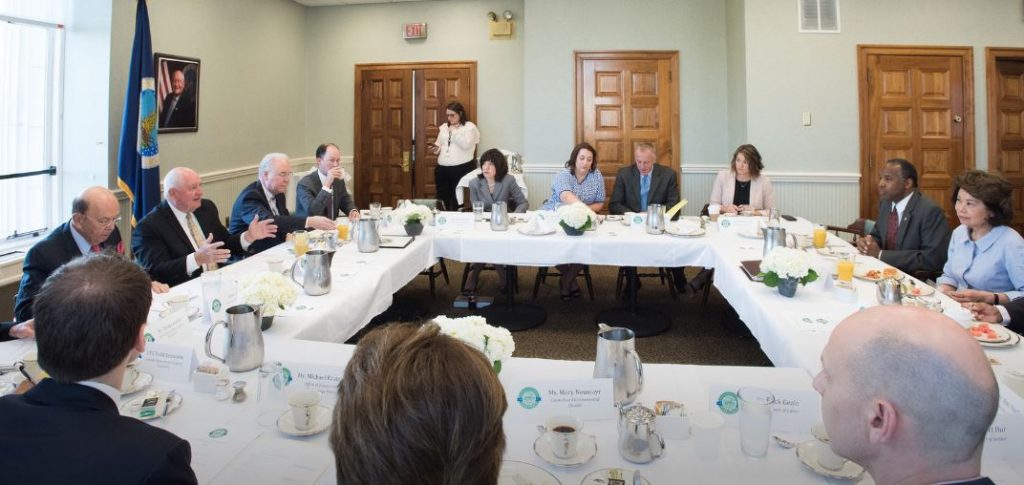Report to the President of the United States from the Interagency Task Force on Agriculture and Rural Prosperity
Rural America includes 72% of the nation’s land and 46 million people. Rural areas encompass regions that focus on agricultural production as well as places where work is more often found in industries such as manufacturing, mining, and forestry. They include locales that are prosperous and rapidly-growing, locales that are chronically depressed, and everything in between.
In April 2017, President Donald J. Trump issued an executive order establishing the Interagency Task Force on Agriculture and Rural Prosperity “to ensure the informed exercise of regulatory authority that impacts agriculture and rural communities.” As Secretary of Agriculture, Sonny Perdue was selected to serve as the chairman of the Task Force, which includes 22 federal agencies as well as local leaders. In response to President Trump’s call to action to promote agriculture and rural prosperity in America, the Task Force envisioned a rural America with world-class resources, tools, and support to build robust, sustainable communities for generations to come. Members of the Task Force met, along with staff involved in separate working groups, to set priorities and a framework. Along the way, the Task Force held several “listening sessions” across the country and gathered recommendations through direct engagement with stakeholders, consultations with state, local, and tribal governments, as well as federal agencies with equity in rural America.
Secretary of Agriculture Sonny Perdue sets the stage for work the Task Force must do to identify legislative, regulatory, and interagency policy changes and actions that promote agriculture and economic development, and quality of life in rural America.
Based on this report and others, with allies such as the African American
Call to Action #1: Achieving e-Connectivity for Rural America
In today’s information-driven global economy, e-connectivity is not simply an amenity – it has become essential. E-connectivity, or electronic connectivity, is more than just connecting households, schools, and healthcare centers to each other as well as the rest of the world through high-speed internet. It is also a tool that enables increased productivity for farms, factories, forests, mining, and small businesses. E-connectivity is fundamental for economic development, innovation, advancements in technology, workforce readiness, and an improved quality of life. Reliable and affordable high-speed internet e-connectivity will transform rural America as a key catalyst for prosperity.
Call to Action #2: Improving Quality of Life
Ensuring rural Americans can achieve a high quality of life is the foundation of prosperity. Quality of life is a measure of human well-being that can be identified through economic and social indicators. Modern utilities, affordable housing, efficient transportation and reliable employment are economic indicators that must be integrated with social indicators like access to medical services, public safety, education, and community resilience to empower rural communities to thrive. Focusing and delivering key federal reforms will enable rural Americans to flourish and prosper in 21st Century communities.
Call to Action #3: Supporting a Rural Workforce
To grow and prosper, every rural community needs job opportunities for its residents, and employers need qualified individuals to fill those needs. This requires identifying employment needs, attracting available workers from urban and rural centers alike, and providing the workforce with training and education to best fill the available needs. There are many opportunities to partner with local businesses and organizations to identify gaps, to work with all levels of educational institutions to provide career training and development, to fine-tune existing training programs, and to grow apprenticeship opportunities to develop the required workforce. Providing rural communities, organizations, and businesses a skilled workforce with an environment where people can thrive will grow prosperous communities.
Call to Action #4: Harnessing Technological Innovation
By 2050, the U.S. population is projected to increase to almost 400 million people, and rising incomes worldwide will translate into historic global growth in food demand. To feed a hungry world, we will need to harness innovation to increase output across American farmlands. In addition to increased crop yields, technological innovation can improve crop quality, nutritional value, and food safety. Innovations in manufacturing, mining, and other non-agricultural industries can enhance worker efficiency and safety. At the core of these developments that will further grow the rural economy is the expansion of STEM education, research, regulatory modernization, and infrastructure. Leveraging these innovations in an increasingly data-driven economy will also require further development of rural data management capabilities.
Call to Action #5: Developing the Rural Economy
Infusing rural areas with stronger businesses and agricultural economies empowers America. Expanding funding options to increase the productivity of farmers and ranchers will lead to the enhanced viability and competitiveness of rural America. By promoting innovative farm technologies, energy security, recreation, agritourism and sustainable forest management, communities will be empowered to leverage the bounties of rural America. Investing in rural transportation infrastructure is needed for carrying more “Made in America” products to markets at home and abroad, and boosting our country’s global competitiveness. Reducing regulatory burdens and attracting private capital will support our ultimate mission of empowering Rural America to clothe and feed the world.
There are approximately 44,000 farmers in the U.S. today are African American citizens.
We do so even in the face of farming in this country that has historically been the domain of people of African Americans —in 1920, for example, blacks made up 14 percent of all the farmers in the nation and worked 16 million acres of land—that tradition has eroded over recent decades as black farmers have struggled to hold onto their farms, often passed down through multiple generations. Today, black farmers make up less than two percent of the farming population in the country. This is the result, farmers and their advocates say, of active discrimination at every level—but particularly from the United States Department of Agriculture, the federal governmental agency that is key to funding farmers and keeping them in business.

President Trump Delivers Remarks at the American Farm Bureau Federation’s 100th Annual Convention (No Mention of African American Farmers)